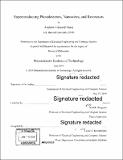| dc.contributor.advisor | Karl K. Berggren. | en_US |
| dc.contributor.author | Dane, Andrew E.(Andrew Edward) | en_US |
| dc.contributor.other | Massachusetts Institute of Technology. Department of Electrical Engineering and Computer Science. | en_US |
| dc.date.accessioned | 2019-11-04T20:21:36Z | |
| dc.date.available | 2019-11-04T20:21:36Z | |
| dc.date.copyright | 2019 | en_US |
| dc.date.issued | 2019 | en_US |
| dc.identifier.uri | https://hdl.handle.net/1721.1/122733 | |
| dc.description | Thesis: Ph. D., Massachusetts Institute of Technology, Department of Electrical Engineering and Computer Science, 2019 | en_US |
| dc.description | Cataloged from PDF version of thesis. | en_US |
| dc.description | Includes bibliographical references. | en_US |
| dc.description.abstract | Despite almost two decades of research on superconducting nanowire single-photon detectors (SNSPDs) and kinetic inductance detectors (KIDs), open questions remain about the photodetection processes in both. In this thesis, we detail our progress towards understanding and engineering two different physical phenomena relevant to most superconducting photodetectors: (1) the thermal boundary conductance between a superconducting metal and dielectric substrate at liquid helium temperatures, and (2) the effect of a spatially varying superconducting gap on the behavior and lifetime of superconducting quasiparticles. Simple electrical measurements are shown to be an effective means of extracting the thermal boundary conductance between superconducting nanowires and various substrates. While our current understanding of this process is based on diffusive heat transfer, we argue that a phonon black-body emission model is more appropriate. We used this understanding to select a substrate in order to thermally isolate the nanowire to improve infrared detection performance. The substrate we identified, polyethylene terephthalate (PET), is a clear, flexible, plastic material, onto which, we were able to successfully fabricate working niobium nitride SNSPDs. Finally, we detail our progress towards understanding how intrinsic variations in the superconducting gap of high-kinetic-inductance materials used to make KIDs, such as titanium nitride or niobium titanium nitride, could affect quasiparticle lifetimes in them. We fabricated and tested superconducting niobium resonators that incorporated gold nanodot decorations, intended to locally suppress the superconducting gap by proximity and provide a physical simulation of the high-kinetic-inductance case, using better-understood materials. | en_US |
| dc.description.statementofresponsibility | by Andrew Edward Dane. | en_US |
| dc.format.extent | 165 pages | en_US |
| dc.language.iso | eng | en_US |
| dc.publisher | Massachusetts Institute of Technology | en_US |
| dc.rights | MIT theses are protected by copyright. They may be viewed, downloaded, or printed from this source but further reproduction or distribution in any format is prohibited without written permission. | en_US |
| dc.rights.uri | http://dspace.mit.edu/handle/1721.1/7582 | en_US |
| dc.subject | Electrical Engineering and Computer Science. | en_US |
| dc.title | Superconducting photodetectors, nanowires, and resonators | en_US |
| dc.type | Thesis | en_US |
| dc.description.degree | Ph. D. | en_US |
| dc.contributor.department | Massachusetts Institute of Technology. Department of Electrical Engineering and Computer Science | en_US |
| dc.identifier.oclc | 1124679733 | en_US |
| dc.description.collection | Ph.D. Massachusetts Institute of Technology, Department of Electrical Engineering and Computer Science | en_US |
| dspace.imported | 2019-11-04T20:21:35Z | en_US |
| mit.thesis.degree | Doctoral | en_US |
| mit.thesis.department | EECS | en_US |
